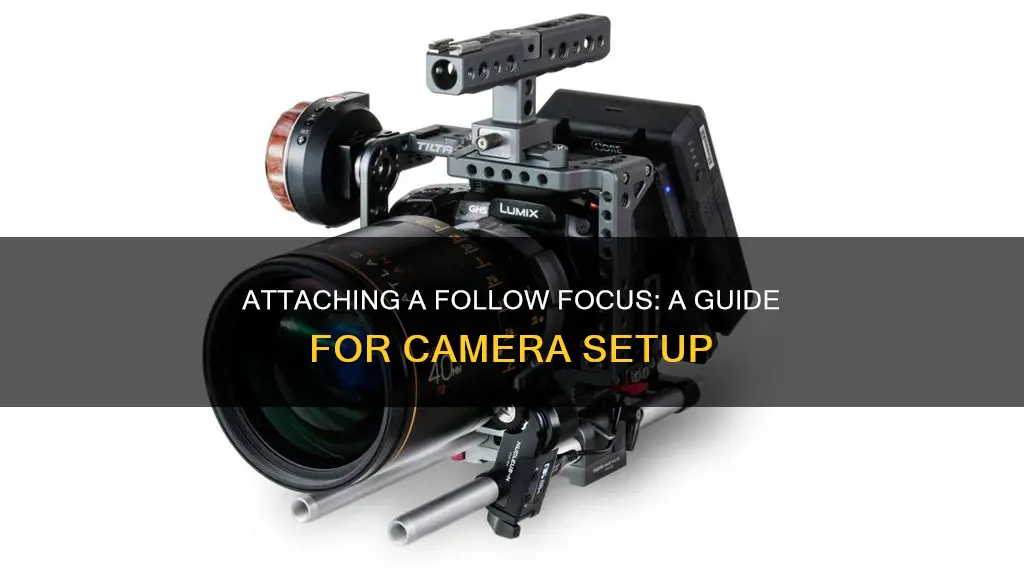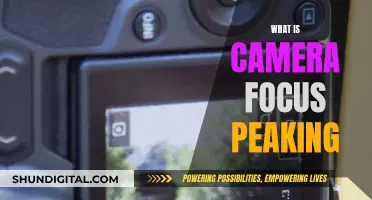
A follow focus system is a mechanism used in filmmaking and television production to help the camera operator achieve more efficient and precise shots. It is particularly useful when filming footage with movement, allowing the camera operator to maintain a consistently clear frame throughout the take. The system is typically operated by a focus puller (often the 1st Assistant Camera or 1st AC) but can also be controlled by the camera operator themselves. The focus puller's job is to adjust the focus onto different subjects and maintain focus during camera movement. In this response, we will discuss how to hook up a follow focus system to your camera.
What You'll Learn

The role of a focus puller
Focus pullers are responsible for pulling focus, which involves changing the camera lens's focus distance in relation to the distance of a moving subject or object from the focal plane. This is a highly skilled and important role, as a "soft" or out-of-focus image is often considered unusable and cannot be corrected in post-production.
In addition to pulling focus, focus pullers also have other duties, such as:
- Organising, loading, and unloading gear
- Helping the cinematographer choose lenses and prepare camera equipment
- Assembling the camera and participating in camera tests and rehearsals
- Taking measurements and marking distances on the focus barrel of the lens or follow focus device
- Collaborating with other departments, such as lighting and grips, to manage exposure and camera movement
- Communicating effectively with the director, cinematographer, and camera operator to ensure the camera's focus aligns with the visual narrative of each scene
- Problem-solving and making adjustments to avoid disruptions in the filming process
Focus pullers need to have a thorough understanding of the different types of focus available and be able to work with various camera systems and accessories, such as wireless follow-focus systems. They must also be able to work well under pressure and adapt to changing circumstances while maintaining precision and accuracy.
Overall, the focus puller plays a crucial role in ensuring the visual integrity of a film, contributing significantly to the seamless storytelling that audiences experience on screen.
How SpyPoint Cameras Behave With Low Battery
You may want to see also

The parts of a follow focus system
A follow focus system is a complex mechanism that attaches to cinema camera lenses or DSLR lenses to improve focusing. It is made up of several components that work together to make smooth focusing possible. Here are the parts of a typical follow focus system:
Rail/Rod Clamp
The rail or rod clamp attaches your follow focus to your camera. It looks like a wrench without the claws and has two holes that slot into a rod and baseplate system attached to your camera.
Arm
The arm connects the rod clamp to the control system's focus gear. Arms can be rigid or flexible, with flexible arms offering improved adjustability with different lenses.
Focus Gear
The focus gear is the connection point between the control knob and the lens-gear ring. It contains tiny, evenly spaced teeth that interlock with other components to achieve focus pulls and other techniques. Focus gears come in various sizes and configurations to help you get the desired results.
Lens Gear Ring
The lens gear ring attaches to the focusing ring on your camera lens. It is a gear belt with evenly spaced teeth that mesh with the teeth on the system's gear to initiate smooth rotation for focusing. Lens gear rings are size-adjustable, but you may need several to accommodate different camera lenses. Some cine lenses have built-in gear teeth, eliminating the need for a lens gear ring.
Focus Knob
The focus knob is the handwheel portion of the focus control system that the camera operator manually rotates to adjust the focus. With more expensive follow focus systems, the knob can be attached to either side for left-hand or right-hand use and can also be set for clockwise or anti-clockwise rotation.
White Disk
The white disk or marking disk is used to mark different focus points with an erasable marker. This helps to keep the shot in sharp focus. Glow-in-the-dark marking disks are also available for improved functionality in darker environments.
In addition to the basic components mentioned above, there are several accessories that can enhance the functionality of a follow focus system, such as a speed crank for quick focus adjustments and additional gears to adjust the focus throw. Wireless follow focus systems also exist, offering remote control capabilities.
Achieving Flawless Skin Tone in Camera Raw
You may want to see also

How to attach a follow focus system to a camera
A follow focus system is a set of mechanisms that enable smooth focus transitions as the camera moves. It is commonly used in filmmaking and television production to help the camera operator achieve precise and smooth focus transitions. Although most professional cameras have autofocus capability, it can be inconsistent when following the action on set.
A follow focus system contains several key pieces, and this guide will take you through the process of attaching one to your camera.
Rail/Rod Clamp
The rail or rod clamp is a rectangular piece that helps attach the follow focus system to your camera. It looks like a wrench without the claws and has two holes that slot into a rod and baseplate system attached to your camera. This is the base of your follow focus setup, so ensure you have the correct baseplate and rods before beginning the installation.
Arm
The arm is the square-shaped piece that attaches the rod to the follow focus system. It can be rigid or flexible, depending on the types of lenses you will be using. For maximum versatility, it is recommended to use a flexible arm that can move laterally and pivot to accommodate different lens sizes.
Focus Gear
The focus gear is a circular, toothed piece that resembles a bicycle gear. It is connected to the arm and the focus knob. When you turn the focus knob, the gear moves the lens gear ring, which in turn adjusts the focus of the camera.
Lens Gear Ring
The lens gear ring fits onto your lens. For most modern follow focus systems, you can attach the lens gear ring by placing your lens face-down on a flat surface and then sliding the gear ring down the lens. You may need to apply gentle pressure to ensure a tight fit.
Focus Knob
The focus knob is the wheel you turn to adjust the focus. It is connected to the focus gear, and when turned, it moves the gear and the lens gear ring, ultimately controlling the focus of the camera. The focus knob should be positioned so that your arm is at your side in a comfortable position, allowing the focus puller to work without disrupting the camera operator.
White Disk
The white disk is a critical component of the follow focus system. It is a stationary disk located near the focus knob, where you can use an erasable marker to note different focus points for your shot. This helps the camera operator quickly adjust the focus as needed during filming.
By following these steps and attaching the various components of the follow focus system, you can improve the precision and stability of your camera's focus, enhancing the overall quality of your footage.
How to Prepare Your Polaroid Camera for Instant Shots
You may want to see also

The benefits of a wireless follow focus system
A wireless follow focus system offers a range of benefits for filmmakers and camera operators. Here are some of the key advantages:
Precision and Control:
Wireless follow focus systems provide greater precision and control over the camera's focus. The system allows the operator to make fine adjustments to the focus without touching the lens directly, resulting in a sharper and more precise image. This level of control is especially useful for blurring the background and drawing the viewer's attention to the intended subject or scene.
Flexibility and Freedom:
Wireless systems offer more flexibility and freedom of movement for the camera operator. They can control the follow focus remotely, reducing the need for a focus whip. This minimizes contact points with the camera, decreasing the risk of bumps, shakes, and human error. It also allows for easier filming with drones, gimbals, and other camera-moving devices.
Improved Stability:
Wireless follow focus systems enhance stability, particularly in run-and-gun style shoots or when using long lenses and camera combinations on a tripod. By removing a point of contact from the camera, wireless systems help eliminate shakiness and ensure smoother footage.
Ease of Use:
Wireless follow focus systems are generally easier to use than manual focus methods. They allow for quick and convenient adjustments without crowding around the camera. This is especially beneficial when working with a team, as it provides more space and flexibility for the camera operator and focus puller to work simultaneously.
Advanced Features:
High-end wireless follow focus systems offer additional features such as digital displays, memory settings, and camera and lens presets. Some systems also provide iris and zoom control (FIZ), giving you even more creative control over your footage.
Compatibility and Range:
Wireless follow focus systems are compatible with a wide range of cameras, including DSLR, mirrorless, and cine-style lenses. They offer varying wireless ranges, from 50 to 1000 meters, utilizing technologies like Bluetooth, radio, and wireless signals. This allows for versatile shooting setups, accommodating both small run-and-gun shoots and larger productions with multiple cameras and angles.
Fight Speeding Tickets: Oregon's Camera Evidence and Your Defense
You may want to see also

The difference between cheap and expensive follow focus systems
A follow focus system is a set of mechanisms that enable the focus to move smoothly with the action. It is a manual add-on that manipulates a camera's lens, keeping the subject sharp and precise by 'pulling' focus. The act of pulling focus to follow the action is known as racking, and the person in charge of it is called a focus puller.
There are many different types of follow focus systems available on the market, ranging from low-budget options to high-end systems. The main differences between these two categories lie in their features, performance, and price.
Low-budget follow focus systems typically have more limited features and may use dry-erase markers or pieces of tape for marking focus points. They often have shorter wireless control ranges and may not offer as smooth an operation as higher-end options. However, they can still be a great choice for those starting out in their careers or for those on a tight budget. An example of a low-budget option is the Neewer A-B Stop Follow Focus, which is available for $40.
On the other hand, high-end follow focus systems offer more advanced features and improved performance. They may include digital displays, the ability to save multiple focus positions and camera and lens presets, and longer wireless control ranges. Additionally, high-end systems often provide more precise control over the focus and may offer additional features such as iris and zoom control. While these systems come at a higher price, they can elevate the quality of footage and are commonly used in professional film productions. An example of a high-end follow focus system is the ARRI Mini Follow Focus, which costs $1,670.
When choosing between a cheap and expensive follow focus system, it is important to consider your budget, the features you require, and the level of precision and control needed for your specific use case.
Is Your SQ8 Camera Charged? Check This Way
You may want to see also
Frequently asked questions
A follow focus system is a mechanism used in filmmaking and television production to help the camera operator achieve more efficient and precise shots. It is especially useful when filming footage with movement, helping to maintain a clear frame throughout the take.
A follow focus system improves the overall quality of your shots, allowing for smooth and accurate focus adjustments. It also eliminates the need to fiddle with the focus ring directly, reducing unwanted movement and shakiness.
The main parts of a follow focus system include the rod clamp or mount, the arm, the gear, the lens gear ring, the focus knob, and the white disk. The rod clamp serves as the base, attaching to the two rods at the camera rig's base. The arm provides flexibility, accommodating different lens sizes. The gear connects to the arm and interacts with the teeth of the focus knob to achieve the desired focus. The lens gear ring wraps around the lens, providing teeth if the lens doesn't have them. The focus knob is used to adjust the focus, and the white disk allows the operator to mark different focus points.
When choosing a follow focus system, consider your specific needs and budget. Look for a system with a smooth-geared mechanism, minimal loose joints, and a clear white disc for marking. If you work with various lenses and cameras, opt for a more complex system that offers different configurations.







